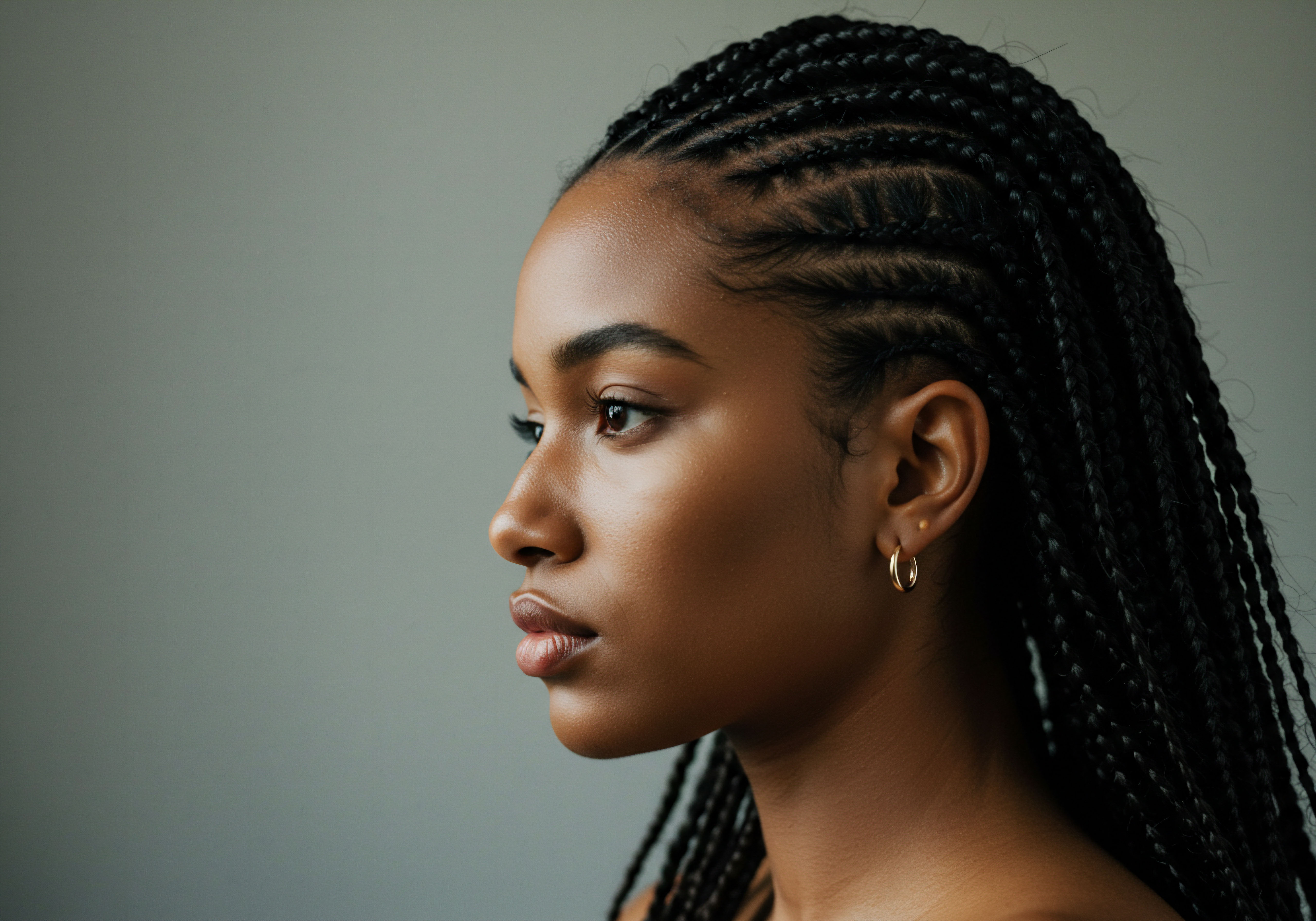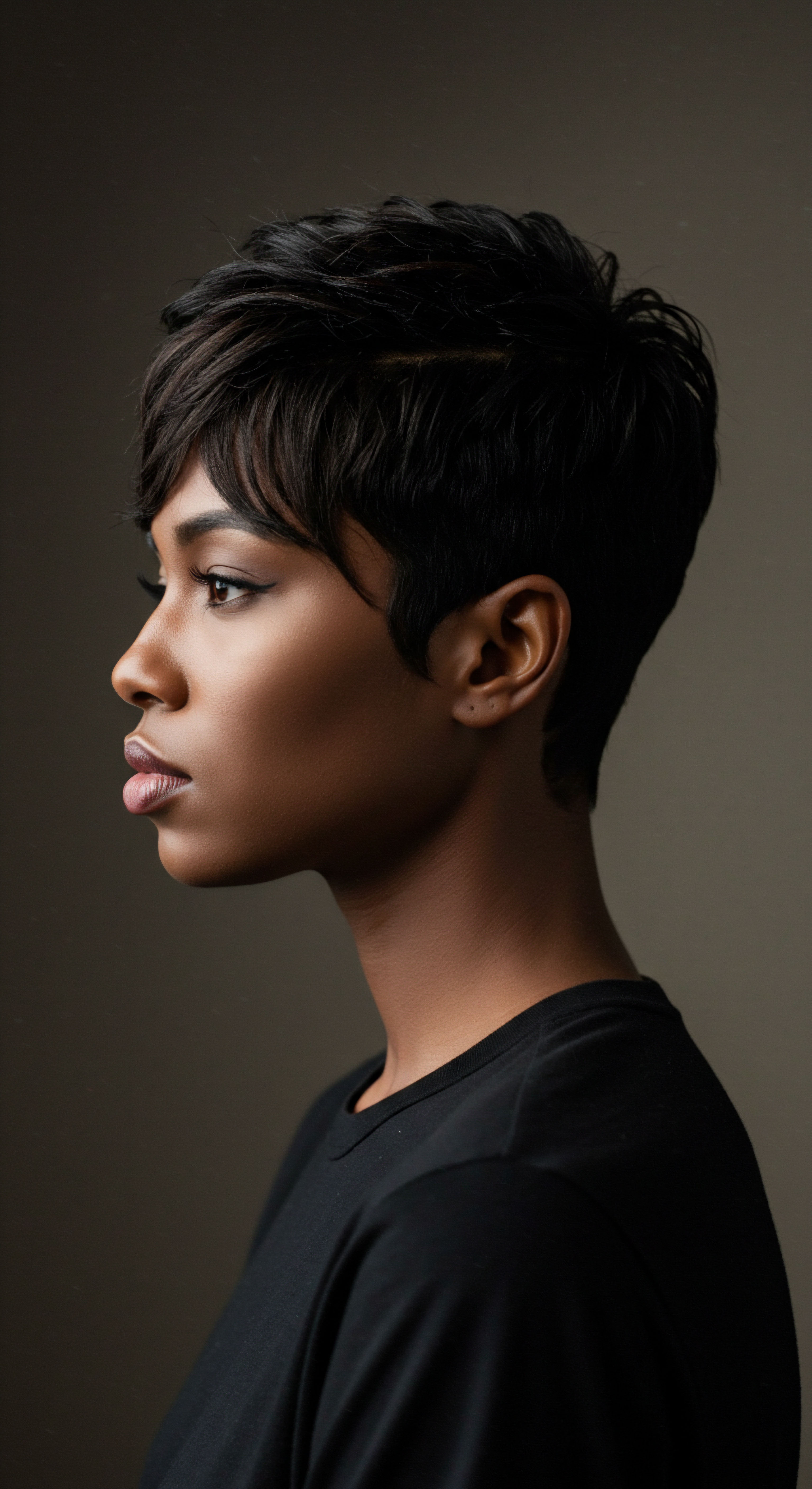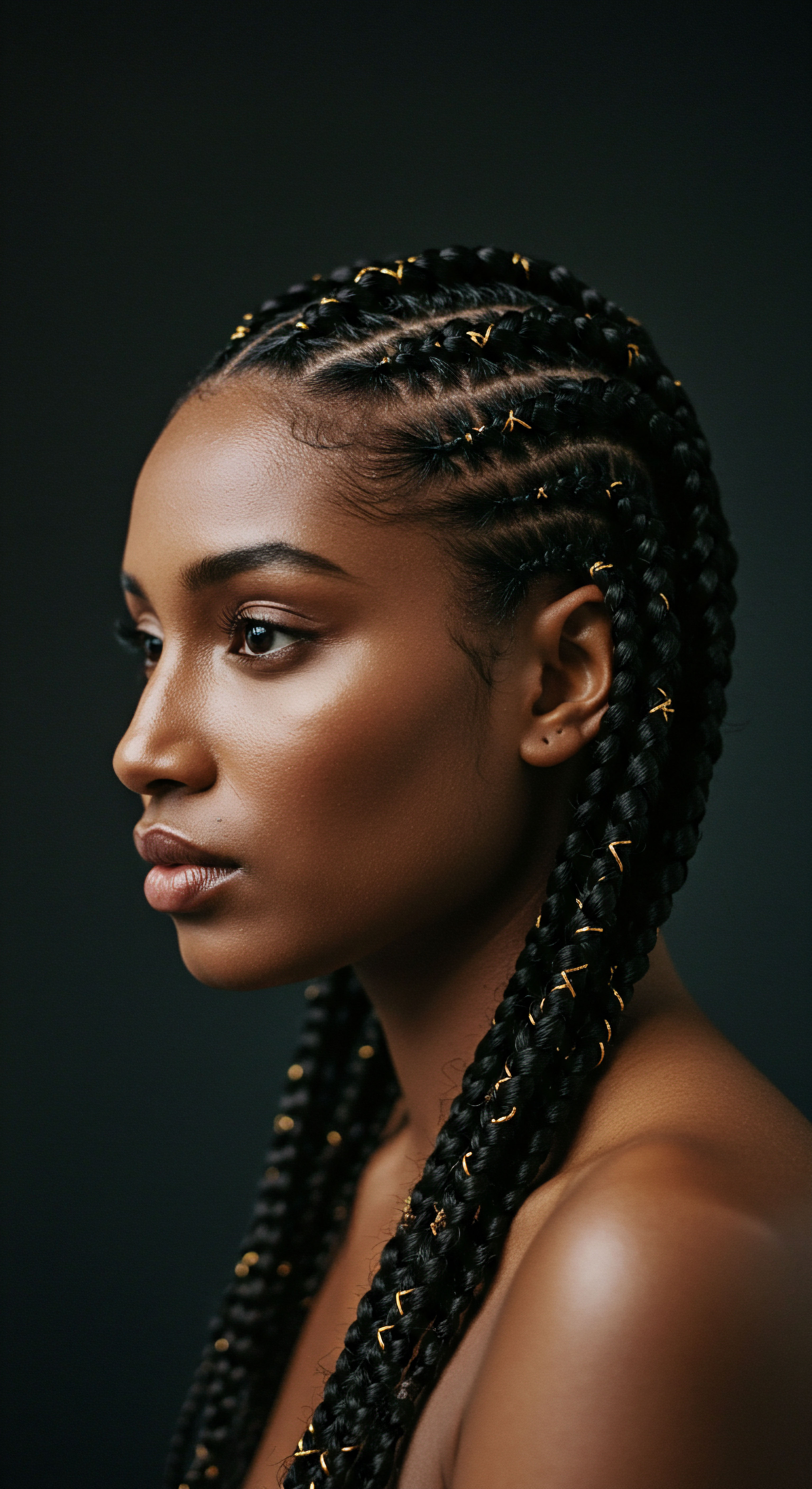
Roots
The very essence of our hair, particularly textured strands, holds stories of resilience, connection, and a deep, ancestral wisdom. Yet, in our modern world, these narratives often encounter unexpected challenges. We find ourselves asking, quietly at first, about the subtle shifts in our hair’s character, the whispers of dryness that linger despite our most earnest efforts. What truly happens when the air we breathe, the water we wash with, and the light we greet each day with, begin to leave their mark?
How do these environmental encounters, over time, shape our hair’s ability to hold onto the very lifeblood of its vitality ❉ moisture? This section seeks to unravel the foundational truths, drawing upon the science of hair itself and the unseen forces that conspire against its innate desire for hydration.

Hair’s Structural Foundation
At its core, hair is a marvel of biological engineering, a proteinaceous filament composed primarily of Keratin. This robust protein provides the hair shaft with its strength and structure. The hair shaft itself comprises three principal layers ❉ the medulla, a central core (not always present); the cortex, which gives hair its strength, elasticity, and color; and the cuticle, the outermost protective layer.
The cuticle, resembling overlapping scales, acts as a guardian, shielding the inner cortex from external harm and playing a pivotal role in moisture retention. When these scales lie flat and smooth, they create a hydrophobic barrier, sealing moisture within the hair.
The surface of healthy hair is coated with a fatty acid called 18-Methyleicosanoic Acid (18-MEA), a naturally occurring lipid that contributes significantly to the hair’s hydrophobicity, smoothness, and shine. This protective lipid layer is crucial for maintaining the hair’s natural moisture balance. Any compromise to this delicate outer shield directly impacts the hair’s ability to repel water and retain its intrinsic hydration.

How Environmental Stressors Disrupt Hair’s Hydration
Environmental stressors represent a constant, often invisible, assault on this delicate hair architecture. Prolonged exposure to elements like ultraviolet (UV) radiation, air pollution, and even the mineral content in water can initiate a cascade of detrimental effects, fundamentally altering the hair’s capacity for moisture retention.
The hair’s outermost cuticle, its protective shield, is a primary target for environmental damage, impacting its capacity to seal in essential moisture.

The Sun’s Unseen Influence on Hair
Sunlight, a source of life, also harbors a less gentle side for our strands. Both UVA and UVB components of solar radiation induce damage. UVB rays primarily affect the cuticle, leading to the breakdown of disulfide bonds crucial for hair’s structural integrity.
This results in increased porosity and irregularities on the hair surface. UVA radiation, while less energetic, penetrates deeper, reaching the cortex and causing partial loss of lipids, proteins, and melanin.
Over time, chronic UV exposure diminishes the vital 18-MEA layer on the hair surface, making the hair more hydrophilic—meaning it attracts water rather than repelling it. This loss of natural protection renders the cuticle and inner structure more susceptible to damage. Additionally, UV radiation degrades amino acids such as cystine, tryptophan, and tyrosine, leading to a weakening of the hair structure, decreased tensile strength, and ultimately, a compromised ability to hold moisture.

The Breath of the City ❉ Air Pollution
Our urban landscapes, vibrant as they are, often carry an unseen burden ❉ air pollution. Particulate matter (PM), volatile organic compounds, and gaseous pollutants settle on the hair and scalp, creating a physical barrier. Beyond mere surface accumulation, these pollutants can penetrate the hair fiber, causing chemical damage to the cuticle and protein structures.
One significant mechanism of pollution-induced damage is Oxidative Stress. Pollutants generate free radicals, highly reactive molecules that degrade hair proteins and lipids. This oxidative modification, particularly protein carbonylation, can lead to a loss of structural integrity in hair fibers and increased cuticle permeability.
A study in 2018 using cigarette smoke to simulate a polluted environment found that exposure caused significant chemical damage to hair, resulting in damaged cuticles, protein degradation, and a more hydrophilic hair surface. This increased hydrophilicity means the hair readily absorbs external moisture but struggles to retain it, leading to persistent dryness and frizz.

The Water We Wash With ❉ Hard Water’s Mark
The very water we use for cleansing can be a silent aggressor. Hard water, rich in minerals such as calcium and magnesium, leaves deposits on the hair shaft. These mineral deposits create a film that impedes moisture from penetrating the hair fiber.
A 2016 study involving 15 female volunteers illustrated this impact. Hair samples washed with hard water for 30 days exhibited a decrease in thickness and a ruffled appearance on the surface, alongside higher mineral deposition, compared to those washed with distilled water. This mineral buildup not only makes hair stiffer and more difficult to comb but also obstructs the hair’s ability to absorb and retain conditioning treatments, culminating in chronic dryness and brittleness.
- UV Radiation breaks down protective lipids and proteins, increasing hair porosity.
- Air Pollution causes oxidative stress and chemical damage to the cuticle, making hair more hydrophilic.
- Hard Water deposits minerals that form a barrier, preventing proper moisture absorption and retention.

Ritual
As we move from the foundational understanding of hair’s delicate composition, our thoughts turn to the rhythms of care, the intentional practices that guide our hands each day. How do these environmental challenges, often invisible, subtly alter the efficacy of our most cherished rituals? We seek not just a remedy, but a deeper harmony, a way to adapt our practices to the world around us, ensuring our textured hair remains a testament to its innate beauty and strength. This section explores how environmental stressors necessitate a thoughtful evolution of our hair care practices, moving beyond simple steps to a more attuned, responsive approach.

Adapting Cleansing Practices for Environmental Realities
The first step in any hair care ritual, cleansing, holds a profound impact, especially when considering environmental aggressors. Our cleansing choices can either fortify or further compromise the hair’s moisture barrier.

Choosing the Right Cleanse
Traditional shampoos, particularly those containing harsh sulfates, can strip the hair of its natural oils, including the crucial 18-MEA layer, leaving the cuticle vulnerable and raised. When hair is already compromised by UV radiation or pollution, this stripping action exacerbates dryness and reduces its ability to retain moisture. Instead, a shift towards gentle, sulfate-free cleansers is a foundational adjustment. These formulations cleanse without unduly disturbing the hair’s natural lipid barrier, preserving its inherent moisture.
For those contending with hard water, the mineral buildup can create a persistent film on the hair, hindering the absorption of conditioning treatments. Incorporating chelating shampoos periodically can be a beneficial practice. These shampoos contain ingredients that bind to and remove mineral deposits, allowing the hair shaft to be truly clean and receptive to moisture. Alternatively, a simple vinegar rinse (diluted apple cider vinegar) can help dissolve some mineral residue and balance the hair’s pH, which often becomes alkaline due to hard water.

The Art of Deep Hydration and Protection
Beyond cleansing, the rituals of conditioning and protection become paramount in safeguarding hair from the long-term effects of environmental stressors. These steps are about building a resilient shield and replenishing what the environment seeks to diminish.
Conscious product selection and consistent protective practices form the bedrock of mitigating environmental harm to hair’s moisture.

Layering Moisture and Sealants
Textured hair, by its very nature, often requires more deliberate moisture application due to its structural characteristics, such as the elliptical shape of the hair shaft and the unique arrangement of cuticle scales. Environmental stressors further amplify this need. A multi-layered approach to hydration, often termed the “LOC” or “LCO” method (Liquid, Oil, Cream or Liquid, Cream, Oil), becomes particularly relevant.
- Liquid ❉ Begin with water or a water-based leave-in conditioner to saturate the hair. This provides the initial surge of hydration.
- Oil ❉ Apply a lightweight oil to help seal in the moisture from the liquid. Oils like jojoba or argan mimic hair’s natural sebum and create a protective layer.
- Cream ❉ Finish with a moisturizing cream or styler that offers additional humectants and emollients to draw in and hold moisture while providing styling benefits.
This method aims to create a barrier that slows moisture evaporation, a critical consideration when facing dry air or wind.

Physical Barriers and Protective Styling
While products offer chemical protection, physical barriers play an equally significant role. Just as we protect our skin from the sun, our hair benefits from similar consideration.
Wearing hats, scarves, or other head coverings offers direct protection against UV radiation and particulate matter. This simple act reduces direct exposure, minimizing protein degradation and lipid loss.
Protective Hairstyles, such as braids, twists, or buns, can also significantly reduce the hair’s surface area exposed to environmental elements. This not only minimizes direct damage but also helps to keep strands bundled, reducing tangling and friction, which can further compromise the cuticle.
| Environmental Stressor UV Radiation |
| Impact on Hair Moisture Degrades proteins and lipids, increases porosity. |
| Ritual Adaptation UV-protective products, hats, scarves. |
| Environmental Stressor Air Pollution |
| Impact on Hair Moisture Causes oxidative stress, damages cuticle, increases hydrophilicity. |
| Ritual Adaptation Gentle cleansing, anti-pollution products, protective styles. |
| Environmental Stressor Hard Water |
| Impact on Hair Moisture Mineral buildup blocks moisture absorption. |
| Ritual Adaptation Chelating shampoos, vinegar rinses, shower filters. |
| Environmental Stressor Humidity Fluctuations |
| Impact on Hair Moisture Causes frizz (high humidity) or dryness (low humidity). |
| Ritual Adaptation Humectant-rich products (balanced), emollients, humidifiers. |
| Environmental Stressor Adapting daily hair care rituals is paramount for long-term moisture retention against environmental challenges. |

The Role of Scalp Health
The scalp is the living foundation from which our hair grows, and its health is intrinsically linked to the hair’s long-term vitality and moisture retention. Environmental stressors can directly impact the scalp, leading to conditions that undermine hair health.
Pollutants can accumulate on the scalp, leading to irritation, inflammation, and excessive sebum secretion, sometimes causing dandruff or even hair loss. This disruption of the scalp’s natural balance can weaken hair follicles, making strands more prone to breakage and less able to thrive. A healthy scalp maintains a slightly acidic pH (between 4.5 and 5.5), which supports the acid mantle and helps keep the cuticle closed. Environmental factors, alongside harsh products, can disrupt this balance, leading to dryness and susceptibility to damage.
Regular, gentle scalp cleansing, along with targeted scalp treatments containing antioxidants or soothing ingredients, can help mitigate these effects. By maintaining a balanced, nourished scalp environment, we provide the optimal conditions for hair to grow strong and retain its moisture from the very root.

Relay
Beyond the visible and the tactile, there exists a deeper conversation between our textured strands and the world they inhabit. What subtle, enduring shifts occur within the hair’s very architecture when it continuously confronts environmental pressures? This section seeks to unravel the less apparent complexities, inviting us into a space where science, cultural practices, and the intricate details of cellular response converge. We will move beyond surface-level observations to understand the profound, sometimes surprising, biological and chemical changes that redefine hair’s moisture narrative over time.

The Cumulative Burden on Hair’s Protein Architecture
Hair, composed predominantly of keratin proteins, possesses a remarkable structural resilience. However, this resilience faces a continuous challenge from environmental elements, leading to cumulative damage that fundamentally alters its ability to hold water.

Oxidative Stress and Protein Carbonylation
One of the most insidious long-term effects of environmental stressors, particularly air pollution and UV radiation, is the induction of Oxidative Stress. This process generates reactive oxygen species (ROS) that attack cellular components, including hair proteins and lipids. A significant outcome of this oxidative assault is protein carbonylation, an irreversible modification where carbonyl groups attach to protein side chains.
Research indicates a dose-dependent increase in carbonylation in both the cuticle and cortex proteins upon exposure to particulate matter and UVA radiation. This chemical alteration weakens the hair fiber’s structural integrity. Carbonylated proteins lead to increased hair porosity and brittleness, directly impairing the hair’s capacity to absorb and retain moisture effectively.
Even if the hair is drenched in hydrating products, the compromised protein structure struggles to hold onto that water, leading to a persistent feeling of dryness and lack of suppleness. This continuous degradation means that hair, unlike skin, cannot regenerate itself once damaged, making long-term protection paramount.

Loss of 18-MEA and Hydrophobicity
The outermost layer of the hair, the cuticle, is naturally coated with 18-methyleicosanoic acid (18-MEA), a lipid that confers hydrophobicity, allowing hair to repel water and maintain its internal moisture balance. Prolonged exposure to UV radiation and alkaline pollutants can degrade this vital lipid layer. When 18-MEA is lost, the hair surface becomes more hydrophilic, meaning it readily absorbs water from the environment but cannot hold onto it, leading to a constant state of dehydration and increased frizz, particularly for textured hair with its naturally raised cuticle scales.
The persistent assault of environmental elements can lead to irreversible protein damage, fundamentally reshaping hair’s inherent moisture-holding capacity.

The Interplay of Microplastics and Hair Health
A less commonly discussed, yet increasingly pertinent, environmental stressor involves Microplastics. These microscopic particles, pervasive in our environment and even present in some hair products, represent a contemporary challenge to hair health.
Microplastics, such as polyethylene, polypropylene, and nylon, can accumulate on the scalp and hair shaft. While research is still emerging, initial findings suggest potential risks. Some microplastics can create a barrier on the hair, preventing moisture from penetrating and leaving strands dry, dull, and weighed down.
A particularly intriguing, and perhaps controversial, area of study relates to the impact of aged microplastics on hair follicles. Research indicates that aged polystyrene microplastics, which contain more oxidized groups due to UV radiation exposure, can induce higher levels of oxidative stress within the hair follicle. This oxidative stress can disrupt the tight junctions between hair follicle cells, potentially leading to a loosening of the epidermal structure at the follicle and contributing to hair loss, as observed in mouse experiments. This suggests a deeper, cellular-level impact that could compromise the very foundation of healthy hair growth and, by extension, its long-term ability to produce well-hydrated strands.
| Environmental Stressor UV Radiation |
| Molecular/Structural Change Degradation of 18-MEA, protein carbonylation, disulfide bond breakage. |
| Long-Term Moisture Effect Increased hydrophilicity, permanent porosity, reduced moisture retention. |
| Environmental Stressor Air Pollution |
| Molecular/Structural Change Oxidative stress, chemical damage to cuticle/cortex proteins. |
| Long-Term Moisture Effect Compromised barrier function, difficulty holding internal moisture. |
| Environmental Stressor Hard Water Minerals |
| Molecular/Structural Change Mineral deposition (calcium, magnesium) on hair surface. |
| Long-Term Moisture Effect Physical barrier to moisture penetration, rough texture, increased breakage. |
| Environmental Stressor Microplastics |
| Molecular/Structural Change Surface barrier formation, oxidative stress in follicles (aged microplastics). |
| Long-Term Moisture Effect Impeded moisture absorption, potential disruption of hair growth cycle. |
| Environmental Stressor The unseen molecular alterations from environmental stressors profoundly diminish hair's inherent ability to retain hydration. |

Hair Porosity ❉ A Consequence of Environmental Wear
The concept of Hair Porosity, which describes hair’s ability to absorb and hold moisture, is not merely an inherent characteristic; it is also a dynamic state heavily influenced by environmental exposure. Long-term environmental stressors invariably lead to increased porosity.
When the cuticle scales are lifted, damaged, or even lost due to the cumulative effects of UV, pollution, or harsh mechanical styling exacerbated by environmental fragility, the hair becomes highly porous. Highly porous hair has gaps in its cuticle layer, allowing water to enter and exit rapidly. While it can quickly absorb moisture, it struggles to seal it within the cortex, leading to rapid dehydration. This phenomenon is particularly challenging for textured hair, which often has naturally raised cuticles, making it inherently more prone to porosity concerns.
The long-term consequence is a cycle of dryness ❉ hair absorbs water, but it evaporates just as quickly, leaving strands feeling dry, brittle, and susceptible to breakage. This constant fluctuation between wet and dry states, coupled with structural damage, means that even with diligent conditioning, the hair’s internal moisture balance remains elusive.

The Systemic Connection ❉ Stress and Hair Moisture
Beyond direct physical and chemical insults, the environmental landscape can also impact hair moisture through systemic pathways, particularly through the body’s stress response. While often overlooked in hair discussions, the psychological and physiological stress induced by environmental challenges can indirectly affect hair health.
Chronic stress, whether from environmental anxieties or other life pressures, can disrupt the normal hair growth cycle. Elevated cortisol levels associated with stress can influence the hair follicle, potentially leading to conditions like telogen effluvium, where hair prematurely enters a resting and shedding phase. While direct links to moisture retention are less direct, a compromised growth cycle and weakened follicles produce weaker strands that are inherently less capable of maintaining their structural integrity and, by extension, their hydration. Furthermore, stress can contribute to oxidative stress throughout the body, indirectly exacerbating the damage already being done to hair proteins by external environmental factors.
This deeper understanding reveals that the quest for hair moisture retention extends beyond topical applications; it reaches into the very fabric of our environment and our body’s intricate responses to it.

Reflection
Our exploration of environmental stressors and hair’s moisture retention brings us to a quiet understanding ❉ our textured strands, so often celebrated for their resilience and beauty, are also tender archives of the world we inhabit. They carry the whispers of the sun, the touch of urban air, and the character of our water. This journey through roots, rituals, and the deeper relay of scientific discovery reveals that the path to vibrant, hydrated hair is a continuous conversation with our surroundings. It is a dialogue that calls for a blend of ancient wisdom and modern insight, a gentle yet persistent commitment to protecting and replenishing, ensuring our hair not only endures but flourishes, echoing the strength and spirit of those who wear it.

References
- 1. NYSCC. (2021). Impact of Environmental Stressors on Hair.
- 2. Li, Y. Wu, X. Fan, J. et al. (2018). Pollution Damage and Protection of Asian Hair. Cosmetics, 5(1), 13.
- 3. Janda, K. & Tomikowska, A. (2024). The Invisible Threat to Hair and Scalp from Air Pollution. Polish Journal of Environmental Studies, 33(4).
- 4. My Derma Store. (2024). The Impact of Climate Change on Hair Health and How to Protect It.
- 5. Rinaldi, F. & Sorbellini, F. (2019). Protein Carbonylation as a Reliable Read-Out of Urban Pollution Damage/Protection of Hair Fibers. Cosmetics, 6(3), 48.
- 6. Laifen-EU. (2024). What is the Hair Cuticle? Structure, Causes of Damage & Repair Tips.
- 7. SALONORY Studio. (2024). Understanding the Hair Cuticle ❉ A Stylist’s Guide.
- 8. SAVE ME FROM. (2018). What is Pollution Doing to Your Hair.
- 9. The Clifford Clinic. (2024). How Does UV Exposure Affect Hair Health And Hair Loss?
- 10. Oxford Biolabs. (2022). Effects of UV Rays on Hair.
- 11. Times of India. (2022). How to protect your hair from pollution?
- 12. NATURALIS – life technologies. (n.d.). DAMAGED HAIR.
- 13. Hoppy Beauty. (2024). Environmental Stressors and Your Hair ❉ How to Protect Against Pollution.
- 14. colleen. (2022). UV and Your Hair.
- 15. Balance Hair Care. (2023). How can humidity affect your hair and how to manage it?
- 16. Zoe Grace Salon & Med Spa. (2016). 8 Environmental Factors That Affect Your Hair.
- 17. Manas Aesthetics. (2025). Sunlight & Hair Fall ❉ How UV Rays Damage Your Hair.
- 18. monpure. (2022). How City Livings Harms Hair and Scalp Health.
- 19. Best Dermatologist in Bangalore. (2023). Sun Damage Protection ❉ How to Shield Your Hair from UV Rays.
- 20. (n.d.). 5 External Enemies Behind Hair Damage And Ways To Prevent It.
- 21. Essential Clinic. (n.d.). Understanding Weather’s Impact on Hair and Scalp Health.
- 22. Organic Harvest Blog. (2024). Damaged Hair Cuticles – What It Is, Causes, Treatment & Prevention.
- 23. Smiths Collective Brands. (2025). The Impact of pH on Hair Health and How to Restore Balance with Professional Haircare, Featuring REF.
- 24. (n.d.). Why Are Microplastics Bad for Curly Hair?
- 25. Rinaldi, F. & Sorbellini, F. (2019). Urban pollution induces irreversible carbonylation of hair proteins. ResearchGate .
- 26. Capilclinic USA Blog. (n.d.). How to protect hair from pollution?
- 27. Curlytops. (n.d.). How to manage curly hair in dry climates.
- 28. The Holistic Enchilada. (n.d.). The Curly Girl’s Guide to Dew Points, Humectants, & Humidity.
- 29. Oxford Biolabs. (2017). The Environment Affects Your Hair More Than You May Think.
- 30. Healthline. (2020). How to Treat and Prevent Hard Water Hair Damage.
- 31. Chemicalbridge. (2024). “Bald”! Microplastics can also cause hair loss.
- 32. Controlled Chaos. (2024). What Does Humidity Do to Curly Hair?
- 33. Srinivasan, G. Srinivas, C. R. Mathew, A. C. & Duraiswami, D. (2015). Scanning electron microscopy of hair treated in hard water. International Journal of Trichology, 7(4), 163–165.
- 34. Portasoft. (2025). Rescue Your Hair from Hard Water.
- 35. Srinivasan, G. Srinivas, C. R. Mathew, A. C. & Duraiswami, D. (2013). Effects of Hard Water on Hair. International Journal of Trichology, 5(3), 137–139.
- 36. Reddit. (2023). Any science behind hard water/calcium changing hair texture, causing breakage?
- 37. Vantage Specialty Chemicals. (n.d.). Case Study ❉ Skinification of Hair Care Formulations.
- 38. BlueMagic Group. (2023). Can Air Pollution Cause Hair Loss? An In-Depth Analysis.
- 39. (n.d.). What is Plastic doing in my Shampoo?
- 40. (n.d.). The Truth About Microplastics in Hair Products (and How to Avoid Them).
- 41. Champo. (n.d.). Glycation | Why we need to address it for long-term hair health.
- 42. MDhair. (2025). Bad Water, Bad Hair ❉ High-Risk States.
- 43. Zhao, J. Yang, J. Wu, W. et al. (2024). Psychological stress induces hair regenerative disorders through corticotropin-releasing hormone-mediated autophagy inhibition. Experimental Dermatology .
- 44. Trueb, R. M. (2010). Oxidative stress in ageing of hair. International Journal of Trichology, 2(1), 6–15.